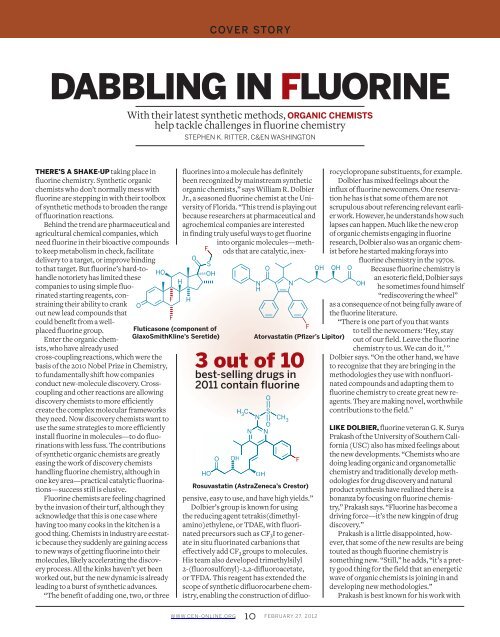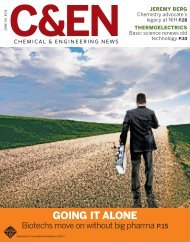February 27, 2012 - IMM@BUCT
February 27, 2012 - IMM@BUCT
February 27, 2012 - IMM@BUCT
Create successful ePaper yourself
Turn your PDF publications into a flip-book with our unique Google optimized e-Paper software.
COVER STORY<br />
DABBLING IN FLUORINE<br />
With their latest synthetic methods, ORGANIC CHEMISTS<br />
help tackle challenges in fluorine chemistry<br />
STEPHEN K. RITTER , C&EN WASHINGTON<br />
THERE’S A SHAKE-UP taking place in<br />
fluorine chemistry. Synthetic organic<br />
chemists who don’t normally mess with<br />
fluorine are stepping in with their toolbox<br />
of synthetic methods to broaden the range<br />
of fluorination reactions.<br />
Behind the trend are pharmaceutical and<br />
agricultural chemical companies, which<br />
need fluorine in their bioactive compounds<br />
to keep metabolism in check, facilitate<br />
delivery to a target, or improve binding<br />
to that target. But fluorine’s hard-tohandle<br />
notoriety has limited these<br />
companies to using simple fluorinated<br />
starting reagents, constraining<br />
their ability to crank<br />
out new lead compounds that<br />
could benefit from a wellplaced<br />
fluorine group.<br />
Enter the organic chemists,<br />
who have already used<br />
O<br />
HO<br />
cross-coupling reactions, which were the<br />
basis of the 2010 Nobel Prize in Chemistry,<br />
to fundamentally shift how companies<br />
conduct new-molecule discovery. Crosscoupling<br />
and other reactions are allowing<br />
discovery chemists to more efficiently<br />
create the complex molecular frameworks<br />
they need. Now discovery chemists want to<br />
use the same strategies to more efficiently<br />
install fluorine in molecules—to do fluorinations<br />
with less fuss. The contributions<br />
of synthetic organic chemists are greatly<br />
easing the work of discovery chemists<br />
handling fluorine chemistry, although in<br />
one key area—practical catalytic fluorinations—success<br />
still is elusive.<br />
Fluorine chemists are feeling chagrined<br />
by the invasion of their turf, although they<br />
acknowledge that this is one case where<br />
having too many cooks in the kitchen is a<br />
good thing. Chemists in industry are ecstatic<br />
because they suddenly are gaining access<br />
to new ways of getting fluorine into their<br />
molecules, likely accelerating the discovery<br />
process. All the kinks haven’t yet been<br />
worked out, but the new dynamic is already<br />
leading to a burst of synthetic advances.<br />
“The benefit of adding one, two, or three<br />
F<br />
F<br />
H<br />
Fluticasone (component of<br />
GlaxoSmithKline’s Seretide)<br />
Atorvastatin (Pfizer’s Lipitor)<br />
3 out of 10<br />
best-selling drugs in<br />
2011 contain fluorine<br />
HO<br />
O<br />
OH<br />
H 3 C<br />
N<br />
S<br />
N<br />
O<br />
N<br />
OH<br />
CH3<br />
Rosuvastatin (AstraZeneca’s Crestor)<br />
WWW.CEN-ONLINE.ORG 10 FEBRUARY <strong>27</strong>, <strong>2012</strong><br />
O<br />
F<br />
F<br />
fluorines into a molecule has definitely<br />
been recognized by mainstream synthetic<br />
organic chemists,” says William R. Dolbier<br />
Jr. , a seasoned fluorine chemist at the University<br />
of Florida. “This trend is playing out<br />
because researchers at pharmaceutical and<br />
agrochemical companies are interested<br />
in finding truly useful ways to get fluorine<br />
into organic molecules—methods<br />
that are catalytic, inex-<br />
F<br />
O<br />
S<br />
O<br />
OH<br />
OH<br />
H<br />
N N<br />
H<br />
pensive, easy to use, and have high yields.”<br />
Dolbier’s group is known for using<br />
the reducing agent tetrakis(dimethylamino)ethylene,<br />
or TDAE, with fluorinated<br />
precursors such as CF 3 I to generate<br />
in situ fluorinated carbanions that<br />
effectively add CF 3 groups to molecules.<br />
His team also developed trimethylsilyl<br />
2-(fluorosulfonyl)-2,2-difluoroacetate,<br />
or TFDA. This reagent has extended the<br />
scope of synthetic difluorocarbene chemistry,<br />
enabling the construction of difluorocyclopropane<br />
substituents, for example.<br />
Dolbier has mixed feelings about the<br />
influx of fluorine newcomers. One reservation<br />
he has is that some of them are not<br />
scrupulous about referencing relevant earlier<br />
work. However, he understands how such<br />
lapses can happen. Much like the new crop<br />
of organic chemists engaging in fluorine<br />
research, Dolbier also was an organic chemist<br />
before he started making forays into<br />
OH<br />
O<br />
fluorine chemistry in the 1970s.<br />
Because fluorine chemistry is<br />
OH<br />
an esoteric field, Dolbier says<br />
he sometimes found himself<br />
“rediscovering the wheel”<br />
as a consequence of not being fully aware of<br />
the fluorine literature.<br />
“There is one part of you that wants<br />
to tell the newcomers: ‘Hey, stay<br />
out of our field. Leave the fluorine<br />
chemistry to us. We can do it,’ ”<br />
Dolbier says. “On the other hand, we have<br />
to recognize that they are bringing in the<br />
methodologies they use with nonfluorinated<br />
compounds and adapting them to<br />
fluorine chemistry to create great new reagents.<br />
They are making novel, worthwhile<br />
contributions to the field.”<br />
LIKE DOLBIER, fluorine veteran G. K. Surya<br />
Prakash of the University of Southern California<br />
(USC) also has mixed feelings about<br />
the new developments. “Chemists who are<br />
doing leading organic and organometallic<br />
chemistry and traditionally develop methodologies<br />
for drug discovery and natural<br />
product synthesis have realized there is a<br />
bonanza by focusing on fluorine chemistry,”<br />
Prakash says. “Fluorine has become a<br />
driving force—it’s the new kingpin of drug<br />
discovery.”<br />
Prakash is a little disappointed, however,<br />
that some of the new results are being<br />
touted as though fluorine chemistry is<br />
something new. “Still,” he adds, “it’s a pretty<br />
good thing for the field that an energetic<br />
wave of organic chemists is joining in and<br />
developing new methodologies.”<br />
Prakash is best known for his work with

















